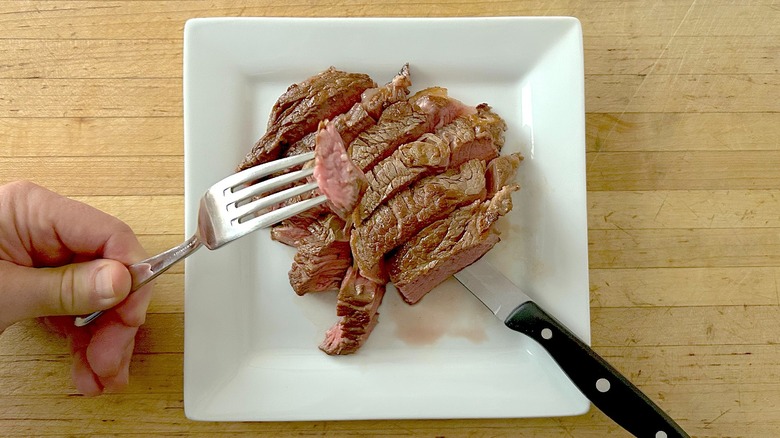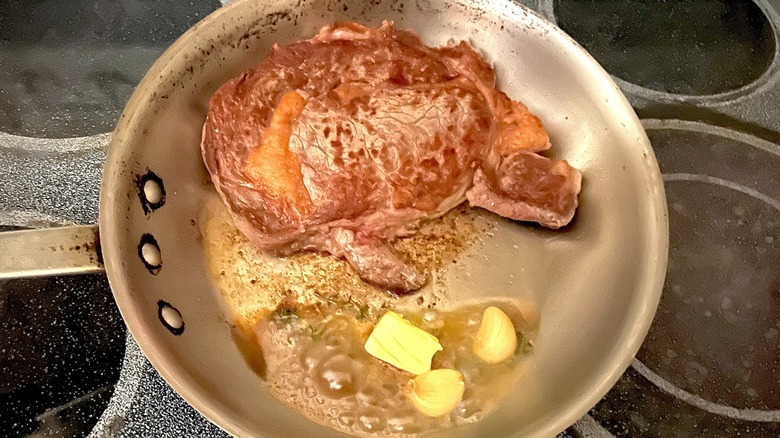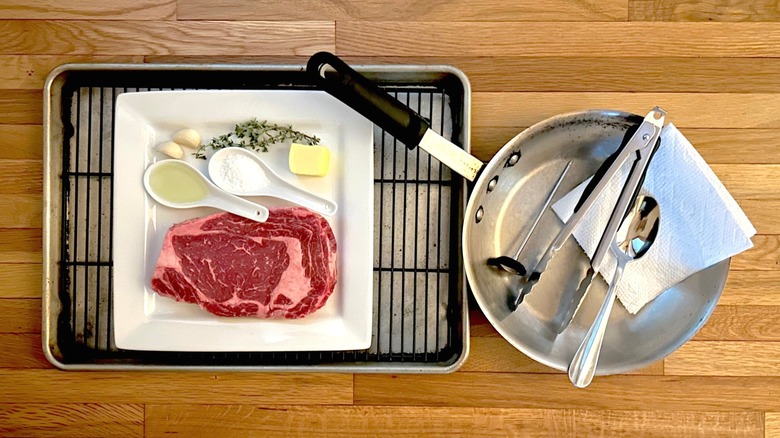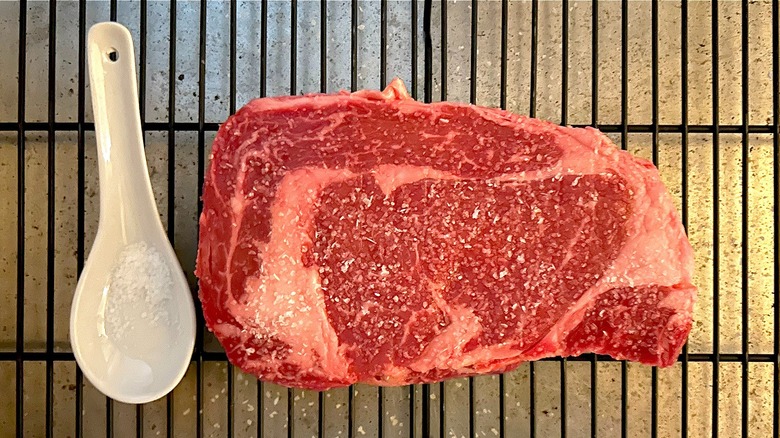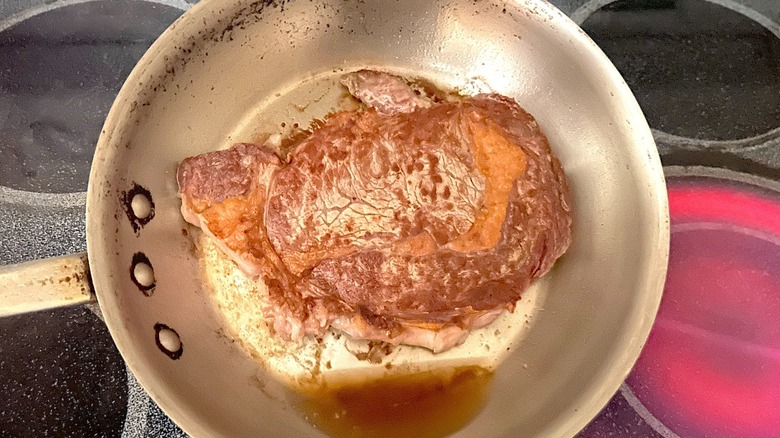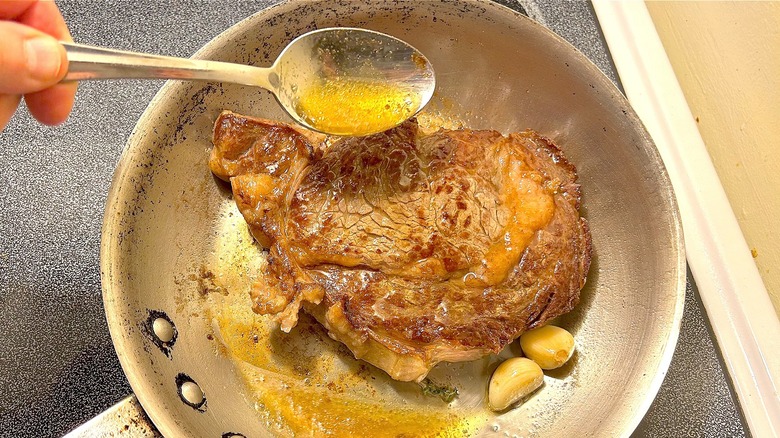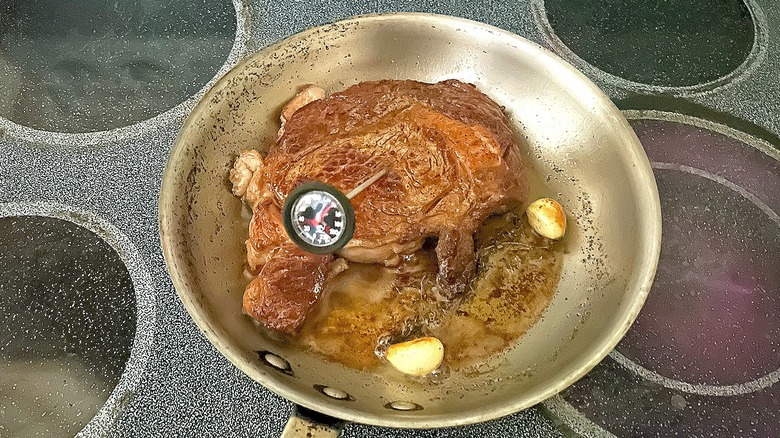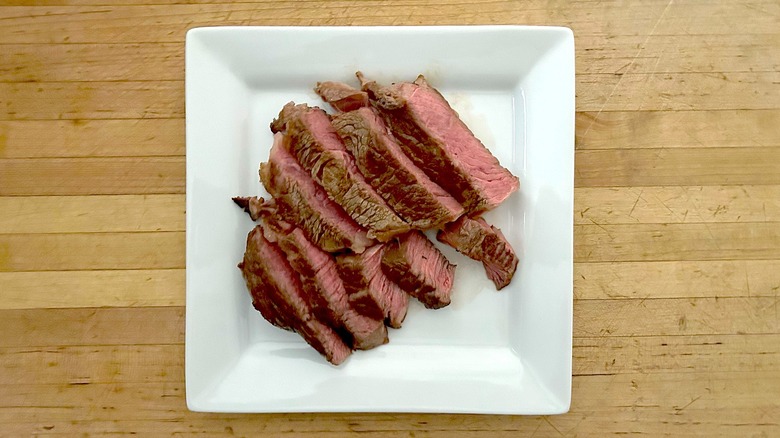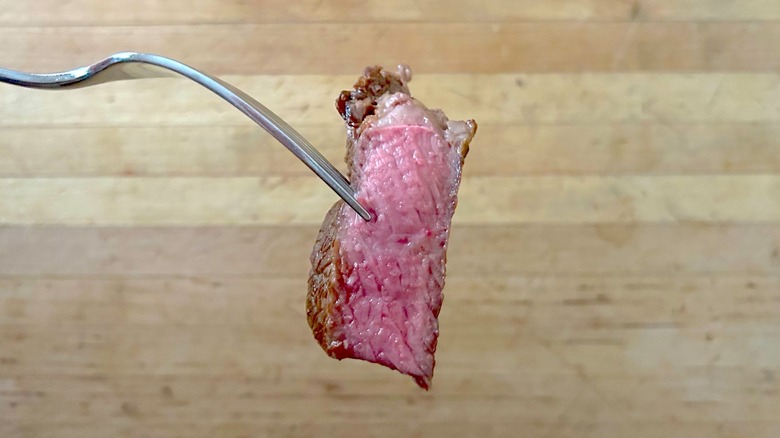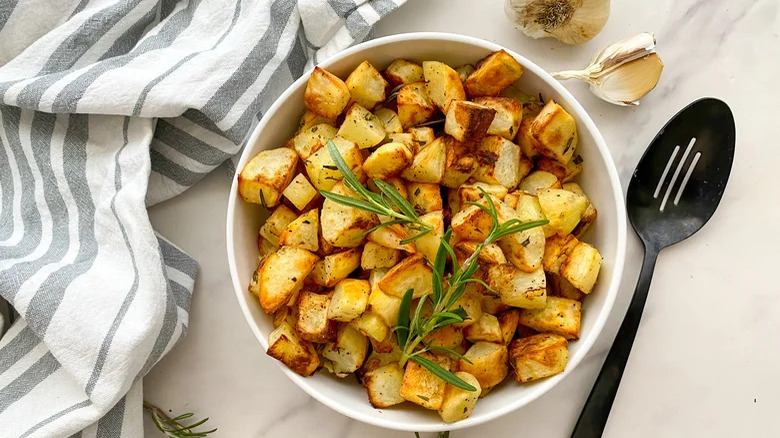How To Butter-Baste Your Steak
Let's face it — few things cause a human to salivate more than the smell of a perfectly cooked steak. When heat is applied to the best cuts of beef, the umami-rich, savory flavor produced is unbeatable. Though you can cook beef in many ways, from reverse-searing or popping it onto the grill to more complex methods like vacuum-sealing them and putting them into sous vide machines, one method has captured the imaginations of those who have ever dined at a fine steakhouse — butter-basting.
Butter-basting is a unique technique that many professional chefs, like myself, use to infuse a steak with maximum flavor, keep it moist, and develop a perfect, crisp crust. This technique can transform even the most affordable cuts of beef from something ordinary to extraordinary. It just takes a little know-how.
That's where I come in. As a culinarian with nearly 18 years of experience, I have butter-basted my fair share of steaks. While the process may seem somewhat complicated, it is relatively easy to execute when you have the right equipment and know exactly what steps to follow. If you want to learn how to butter-baste your steak, read on for all the tips, tricks, and mistakes to avoid. When you take that first bite of succulent butter-basted beef, you'll be glad you took the time to learn this culinary method for cooking steak.
What is a butter-basted steak?
Before delving into the details of how to butter-baste your steak, it may be helpful to understand what this technique is and why it is so effective at cooking meat or fish. Butter-basting involves taking a cut of meat or fish and pan-searing it before cooking it on the stovetop by bathing it in a luxurious blend of browned butter and aromatics. The process can quickly produce a steak with a moist center, crunchy exterior, and rich, nutty, caramelized flavor.
Its superpower is how it jumpstarts the Maillard reaction in meat or fish. The Maillard reaction occurs when meat is cooked beyond 330 F. At this point, the naturally occurring sugars within the beef interact with its amino acids to create compounds that not only develop intense flavor but will transform the color of meat into a bronzed hue. The key is heating the meat enough to allow this reaction to commence without burning your steak. Butter-basting facilitates this with some time, finesse, and active involvement in the cooking process.
This technique is not a set-and-forget-it method of cooking. It does require one to pay attention to the meat from the beginning to the end of the cooking process. It is also not ideal for thin cuts of steak or large roasts. It is best when used with thicker cuts of meat, between one and a half and two inches in breadth.
What tools and ingredients will you need?
Butter-basting requires the following tools and ingredients:
-
A skillet that can withstand high heat, such as one made from cast iron, carbon steel, or stainless steel.
-
Tongs
-
Baking sheet
-
Wire rack
-
Paper towel
Advertisement -
Large spoon
-
Meat thermometer
-
Two plates, one for the raw meat and one for the cooked steak
-
One tablespoon of cooking oil with a high smoke point, such as canola, peanut, or coconut.
-
One tablespoon of high-quality, unsalted butter
-
Aromatics, such as garlic cloves and fresh herbs. I used two garlic cloves and a few sprigs of thyme.
-
One pound of steak (I used a boneless ribeye, but you could use two filet mignons or any other cut you prefer).
-
One teaspoon of kosher salt
Season the steak
Before butter-basting your steak, season it liberally with kosher salt. While you can do so immediately before putting it in the pan, applying the salt in advance and allowing it to dry brine will guarantee the perfect crisp crust. This allows the salt to pull the moisture from the center of the meat to the surface and then be reassimilated into the steak, flavoring and tenderizing it rather than preventing the commencement of the Maillard reaction by causing the beef to steam rather than sear.
Place the steak on a baking sheet lined with a wire rack. Sprinkle kosher salt onto both sides of the steak, factoring approximately one teaspoon per pound of meat. Once the meat has been evenly seasoned, place it into the refrigerator for 40 minutes. Remove the steak from the fridge 15 minutes before you cook it to allow it to come to room temperature. Before you add it to your pan, pat the steak dry thoroughly with a paper towel.
Preheat pan over high heat and sear steak in oil
To start the butter-basting process, drizzle one tablespoon of oil into your skillet and place it over high heat. Using oil rather than butter to start the searing process will ensure that the steak exterior does not burn, becoming bitter. Place the dry, seasoned steak into the hot pan.
Allow the steak to sear for about 30 seconds before rotating the meat. Sear the meat for another 30 seconds and rotate again. Continue this process, turning another two to three times until the beef develops a light-brown crust, but is still rare in the center. Do not cook the meat during this initial searing process. The intent is to ensure the surface of the meat is dry so the Maillard reaction can be initiated.
Add butter and aromatics to pan and begin basting
After the initial searing process, add the butter and aromatics to the pan. Once the butter has browned and is bubbling but not burnt, turn down the temperature to medium-high. Tilt the pan toward you and begin spooning the browned butter over the meat. Turn the steak every 30 seconds or so and baste frequently. If you notice the pan getting too hot, remove it from the heat to cool down the butter so that it doesn't burn.
Check temperature regularly
Check the temperature of the meat with a thermometer regularly. Do not rely on the touch technique to determine the doneness of your steak. It is challenging to master and can be unreliable, leading to over or undercooked meat. This is especially important for thicker steaks. I prefer my beef to be medium-rare, which is between 130-135 F. Adjust the temperature accordingly if you like yours more or less well done.
A quick note regarding doneness: this does not represent what the United States Department of Agriculture considers to be the safe minimum internal temperature for beef of 145 F. That said, most chefs consider it safe to eat a medium-rare steak because the meat's exterior has been exposed to temperatures high enough to destroy any pathogens on the surface of the beef.
Remove the steak from the pan and allow it to rest
Once the steak is cooked to its desired doneness, pull it out of the pan, and place it on a clean plate. Allow the meat to rest for an additional five to seven minutes. During this time, the juices drawn to the surface of the meat during the cooking process can redistribute throughout the steak, keeping it moist and juicy. There is also residual or carryover cooking time, meaning the steak will increase by several degrees in its internal temperature.
Now that you have perfectly butter-basted the steak and have allowed it to rest properly, make sure you slice it correctly. Beef should be cut against the grain, meaning in the opposite direction of the muscle fibers of the meat rather than parallel to it. This will shorten these fibers, making for a more enjoyable chewing experience that is less like a marathon for your jaw.
How to reheat leftover steak
There are several ways to reheat the leftovers so that meat is safe and delicious if you do not eat your entire steak in one sitting. One of the most foolproof methods is to pop the room-temperature steak onto a baking sheet lined with a wire rack and then bake it in an oven preheated to 250 F for approximately 20-30 minutes or until the internal temperature reaches 100 F. Once this occurs, finish the steak by searing it for a couple of minutes per side in a hot pan drizzled with oil to help crisp up the crust.
You can also reheat the steak in an air fryer. Set the unit to 350 F before cooking the meat for three to five minutes. The air fryer has the bonus of crisping the crust without residual oil.
Lastly, you can place the steak into a skillet drizzled with oil over high heat. Sear the steak on both sides briefly before adding two to three tablespoons of water or beef stock to the pan. Bring the liquid to a boil and put a lid on the pan. Allow the steak to steam in the liquid for three to five minutes before consuming.
Recipes for sauces and side dishes
Now that you have the perfect, succulent, medium-rare, butter-basted steak, you want to pair it with the ideal sauce and side dishes. Though all the classic French mother sauces would be delectable atop your steak, a luscious hollandaise or béarnaise is always a good idea. You can also whip up a classic steak sauce with four simple ingredients. For something a bit more exotic, try an herbaceous chimichurri or pesto to brighten things up.
Spuds are a classic side for steak, from a classic luxurious mashed potato to garlic and rosemary roasted potatoes. And don't forget the vegetables. They provide complexity in texture and flavor while adding color to your plate. Sautéed green beans or perfectly seasoned roasted vegetables are always a good bet.
